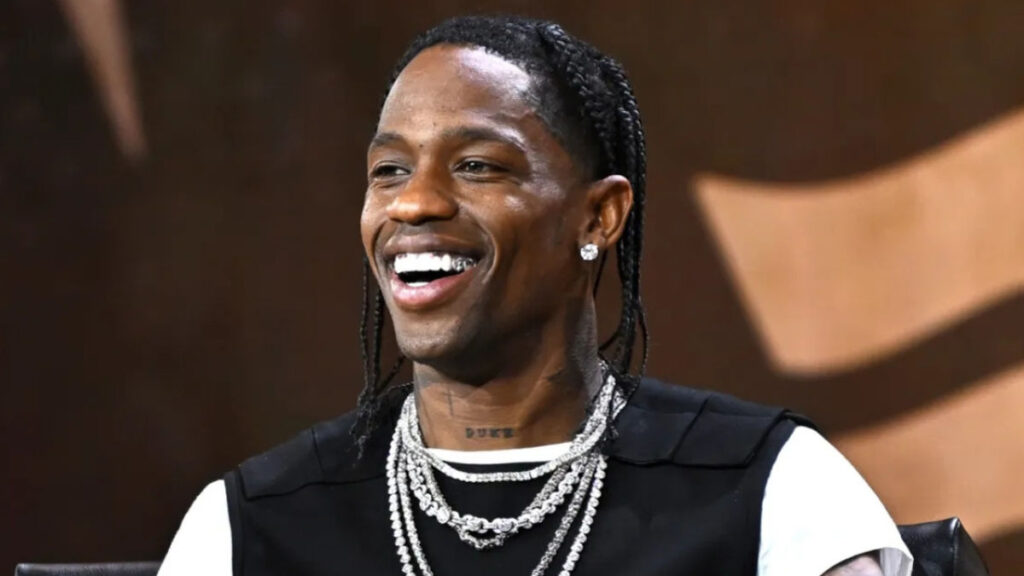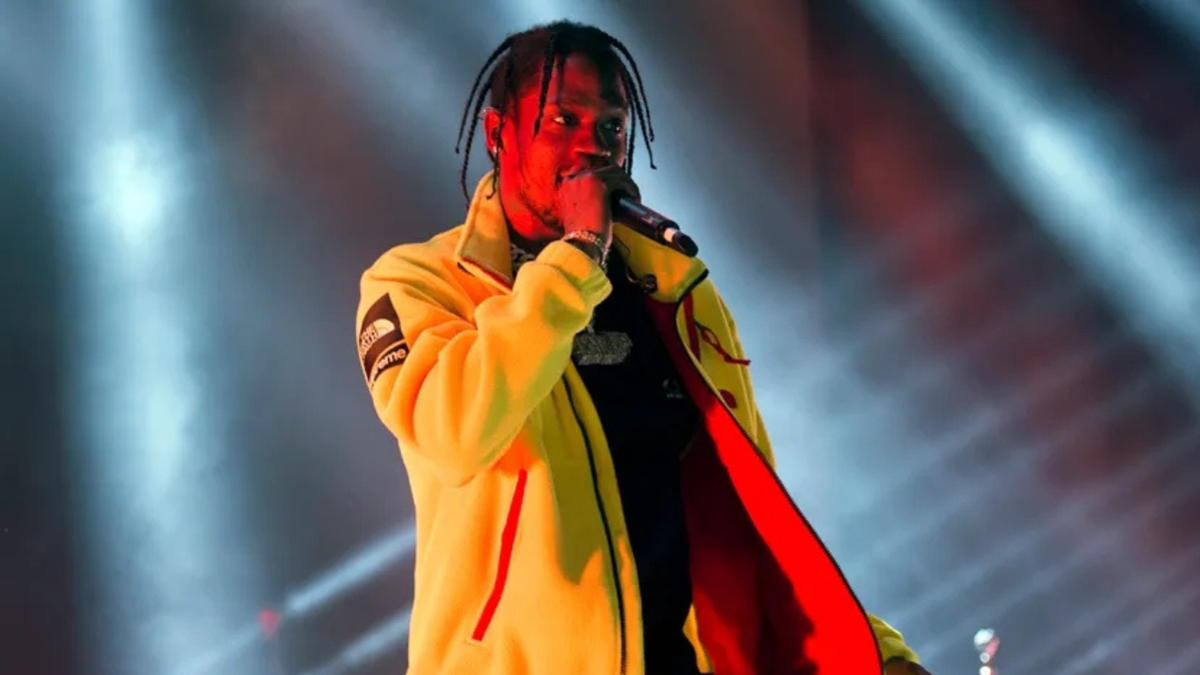Before the brand partnerships, sneaker drops, and multi-million-dollar deals, Travis Scott was just a kid from Missouri City, Texas—obsessed with sound, submerged in synths, and dreaming of stages far beyond his bedroom. Today, he’s not only a chart-topping artist but a hip-hop mogul whose empire stretches from streaming charts to high fashion, fast food, and the metaverse. With an estimated net worth of $80 million, according to Celebrity Net Worth, Scott’s story isn’t just about music—it’s about method.
This isn’t a conventional rags-to-riches tale. It’s the blueprint of a cultural architect—someone who didn’t just follow trends but built ecosystems around them. Through strategic branding, a laser-focused aesthetic, and a relentless ability to merge hype with substance, Travis Scott has engineered a new model for artist entrepreneurship in the 21st century.
In this breakdown, we’ll go beyond the headlines and Forbes lists. We’ll look at how Travis Scott made his money—not just from hits like SICKO MODE or Utopia, but from his disruptive approach to merchandising, brand collaborations, and the ever-evolving machine that is Cactus Jack. The real hustle isn’t just in the music. It’s in the mindset.
Welcome to the business of Travis Scott.
Breaking Down the Bag — What Makes Up Travis Scott’s Net Worth
Music is the Engine, But It’s Not the Whole Car
At the core of Travis Scott’s empire is still the music—loud, layered, and relentlessly immersive. His discography fuels the rest of his business: it’s the engine, even if it’s no longer the entire vehicle.
Streaming platforms have been generous to Scott. With over 54 million monthly listeners on Spotify and billions of total streams, digital royalties alone contribute tens of millions to his net worth. But it’s his touring revenue that hits even harder. The Astroworld tour reportedly grossed over $53 million across 32 dates—a staggering figure that places him among the top live earners in hip-hop.
Add physical and digital album sales (Astroworld went triple platinum, Utopia debuted at No.1), licensing deals for video games and films, and even his signature ad-libs in commercials—music revenue streams stack quickly. But what makes Scott’s music particularly lucrative is its multidimensional appeal: it’s not just consumed, it’s experienced.
From the sonic world-building to his riotous stage presence, Scott transforms each song into a portal. That portal sells concert tickets, merch, and brand equity. His music isn’t just a product—it’s the heartbeat of a lifestyle.
The Merch That Moves Millions
To call Travis Scott’s merch “just merchandise” misses the point entirely. His drops are fashion events, driven by hype, scarcity, and cultural fluency. Each limited-edition release—whether tied to an album, tour, or brand collab—feels like a moment. And that moment is monetized.
The Astroworld collection, for example, wasn’t just a souvenir from a tour—it was a full-blown streetwear line, featuring graphic-heavy tees, hoodies, and accessories that blurred the line between concert merch and fashion capsule. Drops were often time-limited, sold exclusively online, and designed to sell out fast—maximizing FOMO and resale frenzy. Many fans bought two: one to wear, one to flip.
When Travis dropped merch tied to his McDonald’s partnership, the internet nearly imploded. A Chicken McNugget body pillow, $90 Cactus Jack shorts, and vintage-style tees sold out instantly, netting millions. His Fortnite collab followed the same model—exclusive digital and physical bundles that created instant demand.
This is the hype culture blueprint—and Scott executes it with precision. His streetwear business model turns aesthetic alignment into revenue, blending music with fashion in a way few artists have mastered. For Travis, every hoodie is more than clothing—it’s branding with rhythm.
Cactus Jack: The Empire Within the Empire
Cactus Jack isn’t just a label—it’s Travis Scott’s creative nerve center, pulsing with music, design, and strategy. Officially launched as Cactus Jack Records, the imprint gave rise to artists like Don Toliver, Sheck Wes, and SoFaygo—all of whom benefit from Travis’s spotlight and co-sign. But beyond artist development, Cactus Jack operates as a brand incubator, merging sound, style, and visuals under a singular aesthetic vision.
What sets it apart from a traditional music label is creative direction. Every rollout, from music videos to merch, feels curated—intentionally chaotic, vividly branded, and unmistakably “Jack.” It’s a space where Travis doesn’t just release songs—he crafts worlds.
On the business side, Cactus Jack has extended its reach into brand partnerships with titans like Nike, McDonald’s, Fortnite, and Dior. These collaborations often feature co-branded merchandise, digital experiences, and viral marketing that tie back to the Cactus Jack name—creating new revenue streams beyond album sales.
Yes, Travis Scott owns Cactus Jack—but more importantly, he steers it. It’s not just a label. It’s a self-contained ecosystem—one that feeds his music career while expanding his footprint as a multidisciplinary mogul.
The Power of Hype — How Travis Mastered Cultural Collisions
The McDonald’s Meal Heard ‘Round the World
In 2020, Travis Scott pulled off a fast-food branding masterstroke that reshaped the rules of celebrity partnerships. His McDonald’s collab wasn’t just a co-sign—it was a cultural crossover that made fast food cool again. The “Travis Scott Meal”—a Quarter Pounder with cheese, bacon, fries, and Sprite—wasn’t revolutionary in composition, but its rollout was anything but ordinary.
For the first time since Michael Jordan’s 1992 McJordan special, McDonald’s named a meal after a living celebrity. The campaign exploded across social media, with fans reciting the order at drive-thrus (“you know why I’m here”) and flipping limited edition merch—from McNugget body pillows to vintage tees—for hundreds online. It wasn’t just a meal; it was a drop, engineered with the same urgency and scarcity as his sneaker launches.
The partnership reportedly generated over $200 million in sales, but its deeper impact was branding: Travis Scott infiltrated middle America without compromising his aesthetic. It blurred lines between celebrity meals and streetwear hype, between pop culture and product.
For Scott, it expanded his reach far beyond music. For McDonald’s, it reignited relevance with Gen Z. For everyone else, it was proof: in the world of branding, Travis Scott is not just a feature—he’s the main course.
Fortnite, Nike, Dior — Redefining Collabs in Music Marketing
Where most artists lend their name to a brand, Travis Scott builds a universe around it. His collaborations go beyond endorsement—they’re immersive, branded experiences that shift culture.
Take the 2020 Fortnite virtual concert, a boundary-breaking moment in digital entertainment. Over 12 million players watched as a towering avatar of Scott performed inside the game—blurring lines between live performance, animation, and gaming. It wasn’t just a show—it was a media event, signaling how artists can exist in fully virtual ecosystems.
Then there’s his Nike collaborations. From Air Jordan 1s to Cactus Jack Dunks, each drop is treated like an album launch: teaser content, secret release dates, and resale markets that explode minutes after launch. These sneakers aren’t just shoes—they’re cultural collectibles, moving through the same hype cycles as his music.
And with Dior, Travis elevated his brand into luxury fashion. The Cactus Jack x Dior collection fused high fashion and hip-hop, offering runway pieces that reflected his dusty, psychedelic Texas aesthetic. It marked the first time Dior collaborated with a musician in this way.
For Travis, a collab isn’t a side hustle—it’s a story. And every story is crafted to feel unforgettable.
“I Went to Astroworld — and It Felt Like Entering a Billionaire’s Brain”
The moment I stepped through the gates of Astroworld, it didn’t feel like a concert—it felt like I had walked into Travis Scott’s subconscious. The air buzzed with synthetic bass and anticipation. Everywhere, fans wore Cactus Jack hoodies, faces lit by LED merch trucks and carnival rides spinning in the distance. It was loud. Chaotic. Designed to overwhelm—and it worked.
A giant inflatable Travis head towered above the entrance, his mouth wide open. We walked through it like it was a portal to something surreal. The sound design was thunderous—bass that rattled your chest, highs that shimmered like lasers slicing through the smoke. Pyro flared behind the stage. Screams, chants, and laughter blended into something tribal.
Merch lines wrapped around the venue. Some people had already flipped shirts on StockX from inside the crowd. There was no separation between the performance and the brand—it was all one immersive ecosystem, curated down to the fonts on the barricades.
When Travis finally exploded onto the stage, the crowd surged like a living thing. I wasn’t just watching a rapper—I was inside his world. His vision. His brand. It wasn’t just about the music; it was about the feeling of belonging to something electric, reckless, and meticulously designed.
That night, I realized something: Travis Scott isn’t selling songs—he’s selling experience. And every second of it feels engineered for maximum impact.
Not Just Net Worth — How Travis Scott Stacks Up in Hip-Hop’s Wealth Race
In the billionaire-riddled world of hip-hop, Travis Scott’s estimated $80 million net worth might not seem like a chart-topper—but it’s how he’s building it that sets him apart.
Drake hovers around $300 million, with decades of arena tours, lucrative label deals, and a diversified real estate portfolio. Kanye West, even post-Adidas fallout, remains a juggernaut with assets tied to Yeezy, music catalogs, and fashion royalties—worth between $400 million, depending on estimates. Tyler, the Creator, a fellow creative polymath, sits around $30 million, powered by his merch empire and visual storytelling. A$AP Rocky, known for high-fashion collabs and brand appeal, comes in closer to $20 million.
But Travis? He’s building faster than almost anyone, thanks to a future-forward model that fuses music, merch, brand partnerships, and cultural immersion. Where others invest in brands, he is the brand.
| Artist | Estimated Net Worth | Wealth Drivers |
| Kanye West | $400M | Yeezy, Music, Fashion, IP |
| Drake | $300M | Music, Touring, Investments |
| Travis Scott | $80M | Music, Merch, Cactus Jack, Brand Collabs |
| Tyler, The Creator | $30M | Music, Merch, Design, Festivals |
| A$AP Rocky | $20M | Music, Fashion Collabs, Endorsements |
Travis may not lead the pack yet, but he’s pacing like a mogul in the making—and doing it on his terms.
The Risks, The Missteps, and the Resilience
No story about Travis Scott’s rise is complete without acknowledging its darkest chapter: the Astroworld tragedy. In November 2021, during the Houston leg of his festival, a crowd surge led to the deaths of 10 concertgoers and injuries to hundreds more. The incident shocked fans, devastated families, and sparked intense scrutiny of event safety, artist accountability, and the culture of live performances.
Public backlash was swift. Lawsuits mounted. Sponsors distanced themselves. Travis—once viewed as a near-mythical showman—found his image under a microscope. His crisis response, including a televised interview and the launch of a victim support fund, was met with mixed reactions. For many, it raised hard questions: What role do performers play in crowd control? How do artists navigate grief while facing legal consequences?
In the aftermath, Travis retreated—temporarily halting public appearances, brand launches, and music drops. But slowly, methodically, he began rebuilding. His 2023 album Utopia was less bombastic, more introspective. He partnered with Project HEAL, an initiative focused on community and mental health resources. And though some sponsorships hesitated, others—like Dior and Nike—eventually resumed collaborations, signaling a cautious return of brand trust.
The legal impact continues, with court cases unfolding behind the scenes. But what’s clear is this: Travis Scott is no longer just performing for fans—he’s navigating a public reckoning. His resilience and the way he confronts it will shape not just his legacy but how artists are expected to lead in moments of crisis.
Lessons from the Cactus Jack Playbook — What Creators Can Learn
Travis Scott doesn’t just sell music—he sells moments, and that’s what sets his business model apart. For creators looking to follow in his footsteps, the takeaway isn’t to copy his style—it’s to study his strategy.

First, own your brand narrative. From visuals to typography, Travis ensures everything under Cactus Jack speaks with one voice. Second, build ecosystems, not just products. His music, merch, and partnerships are interconnected—each release amplifies the next.
Third, understand the power of strategic scarcity. Limited edition drops and time-sensitive events fuel hype and drive demand. And finally, don’t wait for gatekeepers. Travis built his empire by partnering directly with brands like Nike and McDonald’s on mutual terms, proving that artists can act as creative directors, not just endorsers.
His success isn’t about fame—it’s about focus, consistency, and control. That’s the real blueprint behind the Cactus Jack empire.
Beyond the Money — Why Travis Scott’s Model is a Cultural Case Study
Travis Scott’s story isn’t just about stacking millions—it’s about reshaping the role of the artist in modern culture. In 2025, the lines between musician, entrepreneur, and brand strategist are blurrier than ever, and no one navigates them more fluently than Scott.
He’s not just releasing albums—he’s designing immersive worlds, where fans don’t just listen, they participate. From Fortnite stages to fast-food drive-thrus, he’s turned unlikely platforms into profitable stages. What makes him influential isn’t just his chart performance or net worth—it’s his ability to synchronize creativity with commerce without losing authenticity.
In a digital era where attention is currency, Travis Scott understands the economics of experience. His success shows aspiring creators that cultural capital can be as powerful as financial capital—if you know how to harness it.
More than a rapper, he’s a blueprint for the modern creative mogul. And while the empire may have started with beats, its legacy will be studied far beyond the music industry.
Mohit Wagh is the co-founder of The Graval with over 10 years of experience in SEO and content strategy. He specializes in crafting data-driven, authoritative content that blends cultural insight with digital growth.





5 thoughts on “Inside Travis Scott’s $80 Million Hustle: How Music, Merch, and Cactus Jack Built a Hip-Hop Fortune”